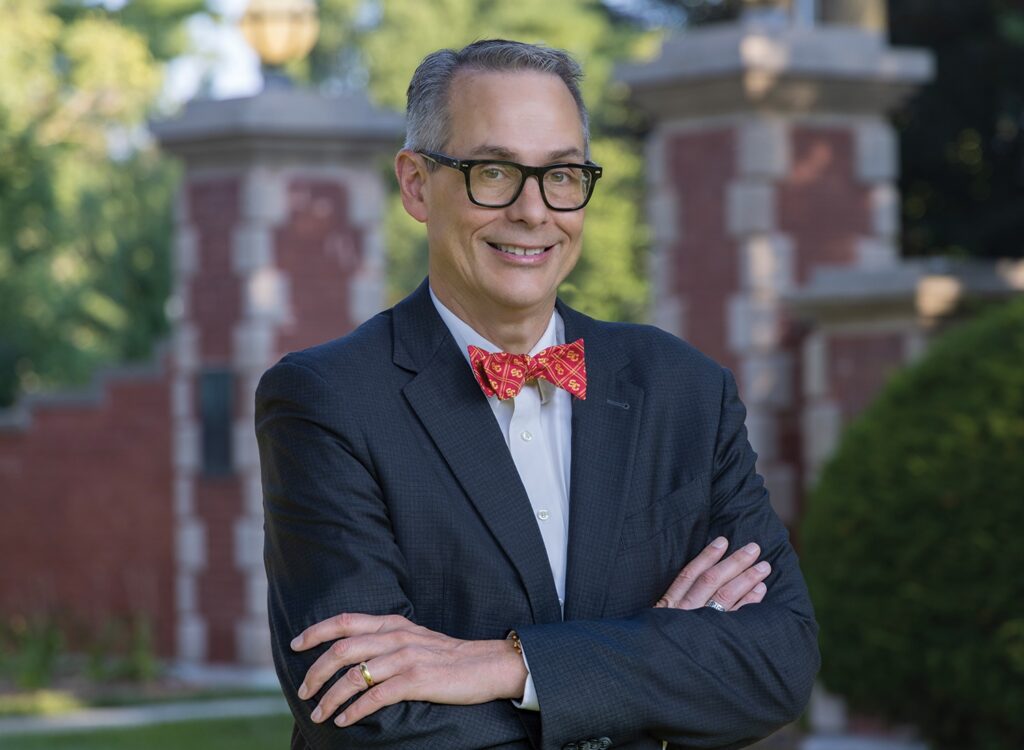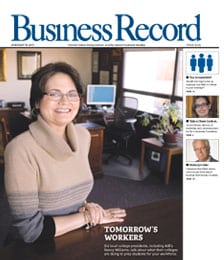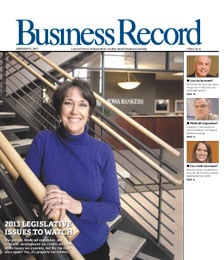Tim Urban’s new urbanism

Developer Tim Urban is bringing an element of the big city to suburbia.
West Glen, a $100 million combination of homes, shops and office space, promises to create West Des Moines’ densest complex. It will help cement George M. Mills Civic Parkway as West Des Moines’ Main Street, a status is has been gaining since the city moved its government offices there from Valley Junction. Urban and West Glen’s investors, who include William Van Orsdel and Gary Kirke, hope it will also give West Des Moines what it has long lacked: a center of town.
Already, West Glen is serving as a sort of model for future projects in the area, spawning copycats, albeit on a smaller scale, elsewhere in Des Moines’ western suburbs. It is one of the first projects in Central Iowa to embrace the tenants of “new urbanism,” a trend sweeping the nation that strives to reduce auto traffic and help foster a feeling of a downtown area, complete with sidewalk shops, restaurants and a town plaza.
“It’s a departure in how we’ve done development,” said Clyde Evans, director of community development for the city of West Des Moines. “West Des Moines is always put up as the poster child for sprawl. This is very much a planned community.”
Workers have already begun construction of a Super Target on the site and are moving earth to prepare for West Glen’s two biggest elements, known as Main Street Village. Those collections of buildings will house nightclubs, art galleries, boutiques, restaurants and performing arts facilities. Tying them together will be small public parks and other landscape amenities.
When it is complete in 2007, West Glen will cover 1.16 million square feet of building space, including 375,000 square feet of retail space, 300,000 square feet of office space, a 175-room hotel and 300 residences. Urban expects the community to provide 2,000 jobs.
Located on the northwest corner of I-35 and Mills Civic Parkway, West Glen is within walking distance of as many as 3,500 homes, Urban said. It is across the street from Glen Oaks, a development financed by Kirke and Van Orsdel, among other investors. The Jordan Creek Town Center and the new office building proposed by Wells Fargo & Co. are farther west along Mills Civic Parkway. These developments and others are pushing growth west, a dynamic that is causing the geographic center of the city to shift very close to where West Glen is located. For those reasons, investors are hopeful that West Glen will come to be known as the city’s heart.
“I believe this has the opportunity to be the town center,” Van Orsdel said. “You’re going to feel like this is it.”
West Glen’s other investors are Robert Pulver, Terry Moss and Robert Horner.
For Urban, the project represents the culmination of a 30-year career that began as a city planner and later morphed into home builder and community developer. In terms of cost, West Glen is more than twice as large as anything the 59-year-old has tackled. Urban prefers to look at the project as a collection of smaller-sized chunks.
“I am not intimidated by doing a project this size at all because each project can stand on its own,” he said.
Part of what is helping Urban shoulder the risk is the way the project is structured. Target owns its building, and it has agreed to employ a unique architectural style to better fit within Urban’s vision for the complex. The Drury Inn & Suites, the hotel in West Glen that is expected to be open in 2005, also owns its building. The First National Bank of West Des Moines plans to build a branch in the development.
Urban, whose father helped Henry A. Wallace found Pioneer Hi-Bred International Inc. and whose brother rose to become chief executive of the seed developer, graduated from Dartmouth College with a degree in art history in 1966. He grew interested enough in development and urban planning through a course he took in urban sociology that he earned a master’s degree in regional planning from the University of North Carolina in Chapel Hill in 1968.
He returned to Central Iowa and went to work on the regional planning commission, a forerunner to today’s Metropolitan Planning Organization. In 1972, he was named West Des Moines’ first planning director, a position he held for close to two years. He left the planning department when, at the age of 26, he beat George Flagg for a spot on the Des Moines City Council.
He formed a development company, Spence Urban and Associates, with John Spence and the pair began building homes. In 1976, he formed Urban Development Corp., his current company. Through the years, he has helped build more than 250 homes.
In the early 1980s, with interest rates soaring, home development came to a near halt across Central Iowa and the rest of the country. As a result, Urban was forced to cut his staff dramatically. The difficulty associated with having to lay off workers he was close to has never left him, he said. Today, Urban Development employs just six people, relying heavily on contracted workers.
In 1984, Urban led the development of Clocktower Square, Clocktower Plaza and Clocktower Professional Park, a combined office park and shopping center. In 1989, Urban Development built the Westridge Shopping Center in Clive. He spearheaded an urban renewal project at the corner of 12th Street and University Avenue. He is currently working on the Windsor Heights Town Center and completing construction and leasing of Somerfield Village Center, a development that includes retail stores and housing located at the southeast corner of 50th Street and Mills Civic Parkway in West Des Moines.
To help smooth out Urban Development’s income, which can be as volatile as the world of commercial and residential development, the company has in recent years been adding more property management capabilities. Urban Development today manages the 65,000-square-foot Uptown Shopping Center at 42nd Street and University Avenue in Des Moines, among other properties. Acting as a property manager has helped Urban better understand the needs of tenants, which he said has made him a stronger developer.
Urban’s background with diverse developments helped sell the West Glen concept both to its investors and to the city of West Des Moines. He has seen similar projects such as Dallas’ Addison Circle, Charlotte, N.C.’s Phillips Place and Columbus, Ohio’s Easton Town Center, and wanted to bring the idea to Des Moines.
Van Orsdel and the other Glen Oaks investors bought the property that West Glen now rests on in the early 1990s. They developed Glen Oaks, but the golf course design ended up not including the West Glen parcel. The land remained undeveloped, Van Orsdel said, until the group could figure out a new project. They were attracted to the idea of an upscale development that could add benefits for Glen Oaks residents. It was Urban who approached them with a plan for West Glen.
“I have always been looking to do things that are on the cutting edge,” Urban said.
What spurred Urban, Van Orsdel and the others to action, they said, was the creation of a larger intersection at I-35 and Mills Civic Parkway to accommodate Jordan Creek. As many as 33,000 people a day travel on Mills Civic Parkway, and more than 60,000 use I-35, Van Orsdel said. When it is completely full, Wells Fargo’s campus could employ as many as 9,000, Van Orsdel said. That traffic will certainly boost West Glen.
“This was the best idea we came up with,” Van Orsdel said.







